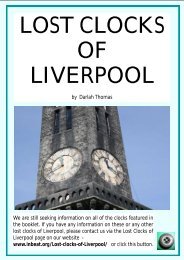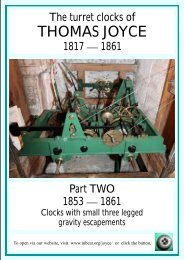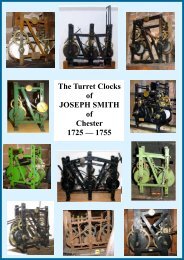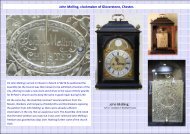Joseph Smith Clockmaker of Barthomley and Chester
Joseph Smith of Barthomley and Chester was a prolific clockmaker in the eighteenth century. Take a look at some of his clocks and read his history.
Joseph Smith of Barthomley and Chester was a prolific clockmaker in the eighteenth century. Take a look at some of his clocks and read his history.
- No tags were found...
Create successful ePaper yourself
Turn your PDF publications into a flip-book with our unique Google optimized e-Paper software.
<strong>Joseph</strong> <strong>Smith</strong> three train turret clock for <strong>Chester</strong> Cathedral, continued<br />
The payment was increased occasionally if repairs were required, for example<br />
one <strong>of</strong> the bells was sent to London for re-casting during the 1730s; on 18 th<br />
December 1738-9, after the bell’s return this entry was put in the accounts<br />
book: ‘To Mr <strong>Smith</strong> for cleaning <strong>and</strong> regulating the clock after the Great Bell<br />
was put up - £0 9s 0d.’<br />
<strong>Joseph</strong> <strong>Smith</strong>’s connection with the cathedral was made even closer when he<br />
sent his boys to the King’s School. The school was founded by King Henry VIII<br />
in 1541 following the dissolution <strong>of</strong> St Werburgh's Abbey, which became<br />
<strong>Chester</strong> Cathedral. It was housed in the former monastic refectory for most<br />
<strong>of</strong> the next 400 years. It was to have twenty-four poor <strong>and</strong> friendless boys<br />
aged between nine <strong>and</strong> fifteen. The boys, usually termed King's Scholars,<br />
were elected by competitive examination <strong>and</strong> received a free education <strong>and</strong><br />
an allowance. The ‘poor <strong>and</strong> friendless’ requirement must have been less<br />
stringently enforced as the years passed. <strong>Joseph</strong>’s eldest son, John was first<br />
listed as a King’s Scholar in the account book in 1733, followed by Gabriel(2)<br />
in 1735, Thomas in 1737 <strong>and</strong> Samuel in 1742. It is not known how long the<br />
boys attended the school, but Samuel was still there in 1745.<br />
In October 1744 Thomas was paid the year’s salary for taking care <strong>of</strong> the<br />
clock <strong>and</strong> the following year, Mrs <strong>Smith</strong> collected her husb<strong>and</strong>’s salary.<br />
Payments to <strong>Joseph</strong> then continued until 1763, when Gabriel(2) was paid ‘his<br />
year’s salary’. After that time, <strong>Joseph</strong> was paid for three more years, the final<br />
payment to him being on 4 th April 1766. John <strong>Smith</strong> continued the<br />
maintenance <strong>of</strong> the clock until his last salary was paid on 9 th November 1781.<br />
The <strong>Smith</strong> clock continued in service until 1872/3 when it was replaced by a<br />
flatbed Westminster chiming clock made by JB Joyce & Co. <strong>of</strong> Whitchurch.<br />
Like its predecessor, the Joyce clock had no dial, but simply told the time by<br />
full quarter chiming <strong>and</strong> striking the hours. At the time <strong>of</strong> the clock’s<br />
installation, the 1867 carillon was re-sited. It lessened the job <strong>of</strong> the<br />
bellringers, by playing the first lead <strong>of</strong> Bob Triples. The Joyce clock <strong>and</strong><br />
carillon were themselves superseded by an electric chiming mechanism<br />
which was installed in the new Addleshaw Bell Tower when it was completed<br />
in 1975.










